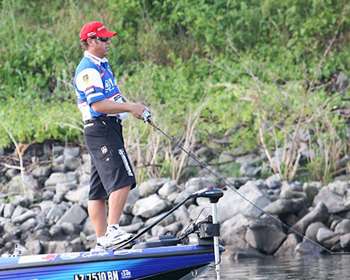
To most bass fishermen, there's nothing better than an explosive strike on a topwater bait. Whether that bait is a buzzbait or a hollow-bodied frog, anglers are seemingly hooked on the water-shattering bites that either can elicit. The problem is that many anglers are often confused as to exactly when the best topwater action takes place.
"Water temperature is one of the most critical aspects to topwater fishing," Elite Series pro Dean Rojas explains. "To me, the optimal temperature is when the water starts crossing the 50-degree barrier. Topwater fishing stays hot when the water temperature is will into the 90-degree range."
With a widely known affinity for one topwater bait in particular, the hollow-bodied frog, Rojas has proven he can get surface action even when most would argue conditions aren't necessarily ideal. However, he still maintains that to be most effective, anglers should heed the basic rule of conditions.
"I've caught bass in really cold water on the frog," he says. "Basically, though, you want to focus your topwater efforts in water that's 50 degrees or warmer."
As spring approaches, anglers are automatically drawn to topwater offerings; however, as fall transitions to winter, the question of when to put the surface plugs away can be tricky.
"It all depends on the fish," Rojas says. "I don't rule out topwater completely because I've seen them schooling in late fall plenty of times.
"It's always nice to have one tied on because you just never know what the bass are going to do. In fact, I came in second with a frog at a Sam Rayburn tournament when no one was throwing a topwater bait because the water temps were in the low 50s."
Rojas admits that his travels across the country have lead him to understand that bass can, and will, react to a topwater bait in colder water — particularly in certain parts of the country.
"The clear water impoundments will have a better topwater bite later in the year as opposed to the lakes with stained or muddy water," he says.
He also adds that late in the season, as air temperatures fall, the water temperatures might not drop as fast, and that can lead to some lingering topwater action.
"If the air temperatures have been warm, and then you get a big cold front that cools everything off overnight, don't be afraid to try it," he says. "I've had some really good days with a frog when the air temps were really cold, but the water hadn't cooled nearly as fast."
Rojas reveals that as the water cools, the speed of retrieve becomes critical.
"Obviously, the colder the water, the slower that you want to work your bait," he says. "Likewise, the warmer the water, the faster that you need to be moving the bait. Still, you need to be listening to how the fish want the offering."
Rojas explains that he varies his bait selection based on the season and will generally reserve big topwater baits (like a Super Spook or Pencil Popper) for only narrow windows when conditions are at their peak.
"It seems like earlier in the season, they want something that walks rather than pops or spits," he says. "As the water warms, bass tend to prefer a bait that pops or has blades (propellers) on it. I think that's because they're more active and willing to travel from a greater distance for the bait."




